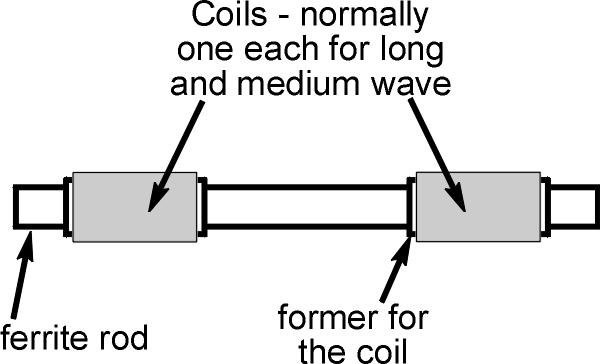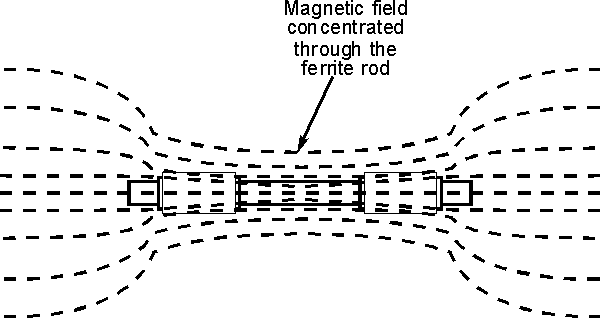Ferrite rod antenna
- an overview the basics of the ferrite rod antenna, a form of RF antenna
that is widely used in transistor radio applications.
The ferrite rod antenna is a form of RF antenna design that
is almost universally used in portable transistor broadcast receivers as well as
many hi-fi tuners where reception on the long, medium and possibly the short
wave bands is required. As the name suggests the antenna consists of a rod made
of ferrite, an iron based magnetic material. A coil is would around the ferrite
rod and this is brought to resonance using a variable tuning capacitor contained
within the radio circuitry itself and in this way the antenna can be tuned to
resonance. As the antenna is tuned it usually forms the RF tuning circuit for
the receiver, enabling both functions to be combined within the same components,
thereby reducing the number of components and hence the cost of the set.

Typical ferrite rod antenna assembly used in a portable
radio
The ferrite rod antenna operates using the high permeability
of the ferrite material and in its basic form this may be thought of as
"concentrating" the magnetic component of the radio waves. This is brought about
by the high permeability μ of the ferrite.
The fact that this RF antenna uses the magnetic component of
the radio signals in this way means that the antenna is directive. It operates
best only when the magnetic lines of force fall in line with the antenna. This
occurs when it is at right angles to the direction of the transmitter. This
means that the antenna has a null position where the signal level is at a
minimum when the antenna is in line with the direction of the transmitter.

Operation of a ferrite rod antenna
This form of RF antenna design is very convenient for
portable applications, but its efficiency is much less than that of a larger RF
antenna. The performance of the ferrite also limits the frequency response.
Normally this type of RF antenna design is only effective on the long and medium
wave bands, but it is sometimes used for lower frequencies in the short wave
bands although the performance is significantly degraded, mainly arising from
the losses in the ferrite. This limits their operation normally to frequencies
of only a MHz.
Ferrite rod antennas are normally only used for receiving.
They are rarely used for transmitting anything above low levels of power in view
of their poor efficiency. It any reasonable levels of power were fed into them
they would soon become very hot and there would be a high likelihood that they
would be destroyed. Nevertheless they can be used as a very compact form of
transmitting antenna for applications where efficiency is not an issue and where
power levels are very low. As they are very much more compact than other forms
of low or medium frequency RF antenna, this can be an advantage, and as a result
they are being used in applications such as RFID.
The need for Q
One of the requirements for an efficient ferrite rod antenna
is that it should have a high Q at the frequencies over which it operates. At
frequencies of a few hundred kilohertz, a medium permeability material would be
used and this would enable a Q of about 1000 to be obtained. With a Q of this
value it will mean that the antenna will need tuning if it is to operate over
more than a single channel or frequency. When used in a portable receiver, the
tuning can be linked to the overall receiver tuning and indeed the ferrite rod
antenna normally provides the input tuning for the set.
The Qs of the overall antenna may appear very high, and in
fact the ferrite in a rod form has a much higher Q than the basic material as a
result of the fact that the rod forms an open magnetic circuit.
Radiation resistance
One of the advantages of using a ferrite in the antenna is
that it brings the radiation resistance of the overall antenna to a more
reasonable level. The ferrite rod antenna can be considered as a small loop
antenna. In view of its size, the loop is much less than a wavelength in length
and without the ferrite it would have a very low radiation resistance.
Accordingly the losses due to the resistance of the wire would be exceedingly
high. Placing the ferrite core in the coil has the effect of raising the
radiation resistance by a factor of μ^2, and thereby bring the value into more
acceptable limits.
While the introduction of the ferrite rod raises the
radiation resistance of the antenna, and hence reduce the losses due to the
resistance of the wire, it does introduce other losses. The ferrite itself
absorbs power. This arises from the energy required to change the magnetic
alignment of the magnetic domains inside the granular structure of the ferrite.
The higher the frequency, the greater the number of changes and hence the higher
the loss.
Summary
The ferrite rod antenna is a particualrly useful form of RF
antenna design despite its limitations and drawbacks in terms of efficiency, top
frequency and the need for tuning. Nevertheless ferrite rod antennas are widely
used, being used almost universally as the RF antenna in portable radios for
long and medium waveband reception as well as being used in a number of RFID
applications.
|

